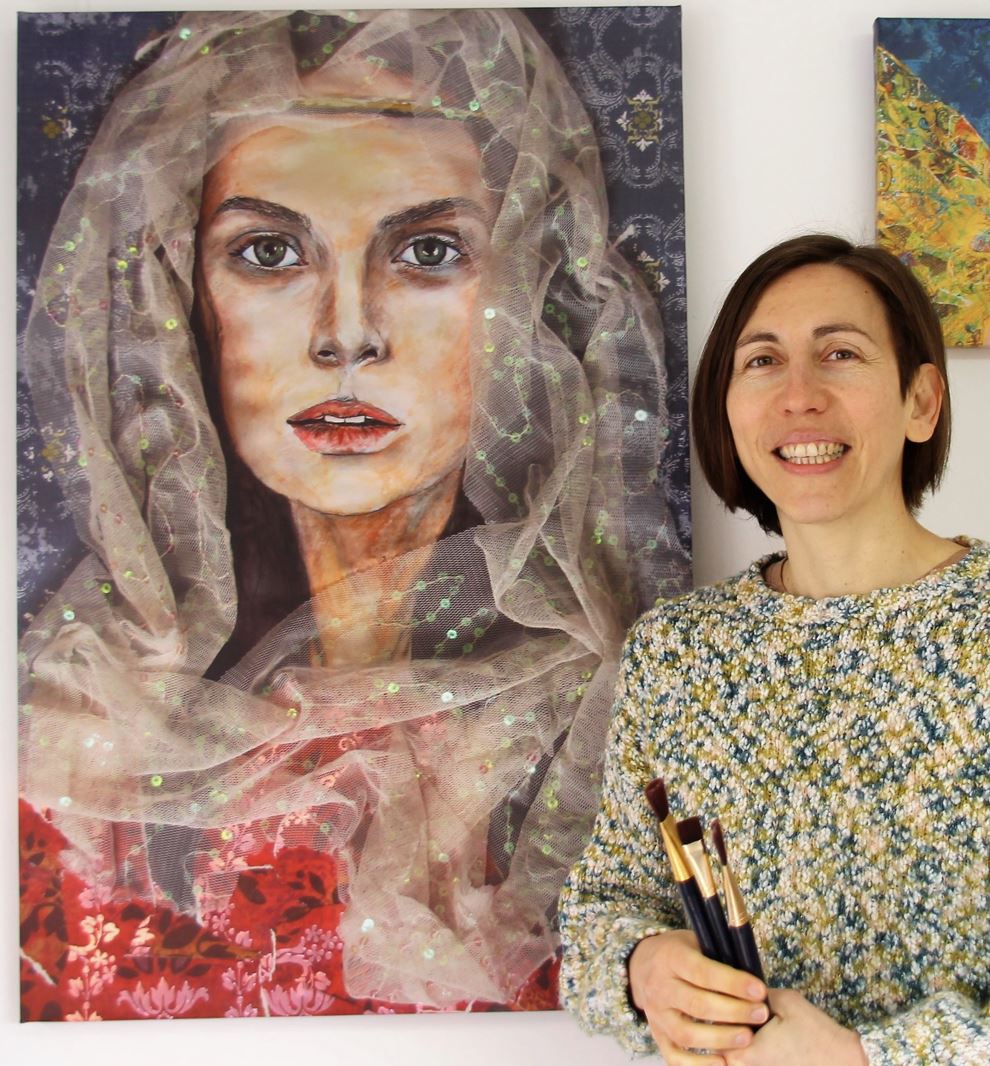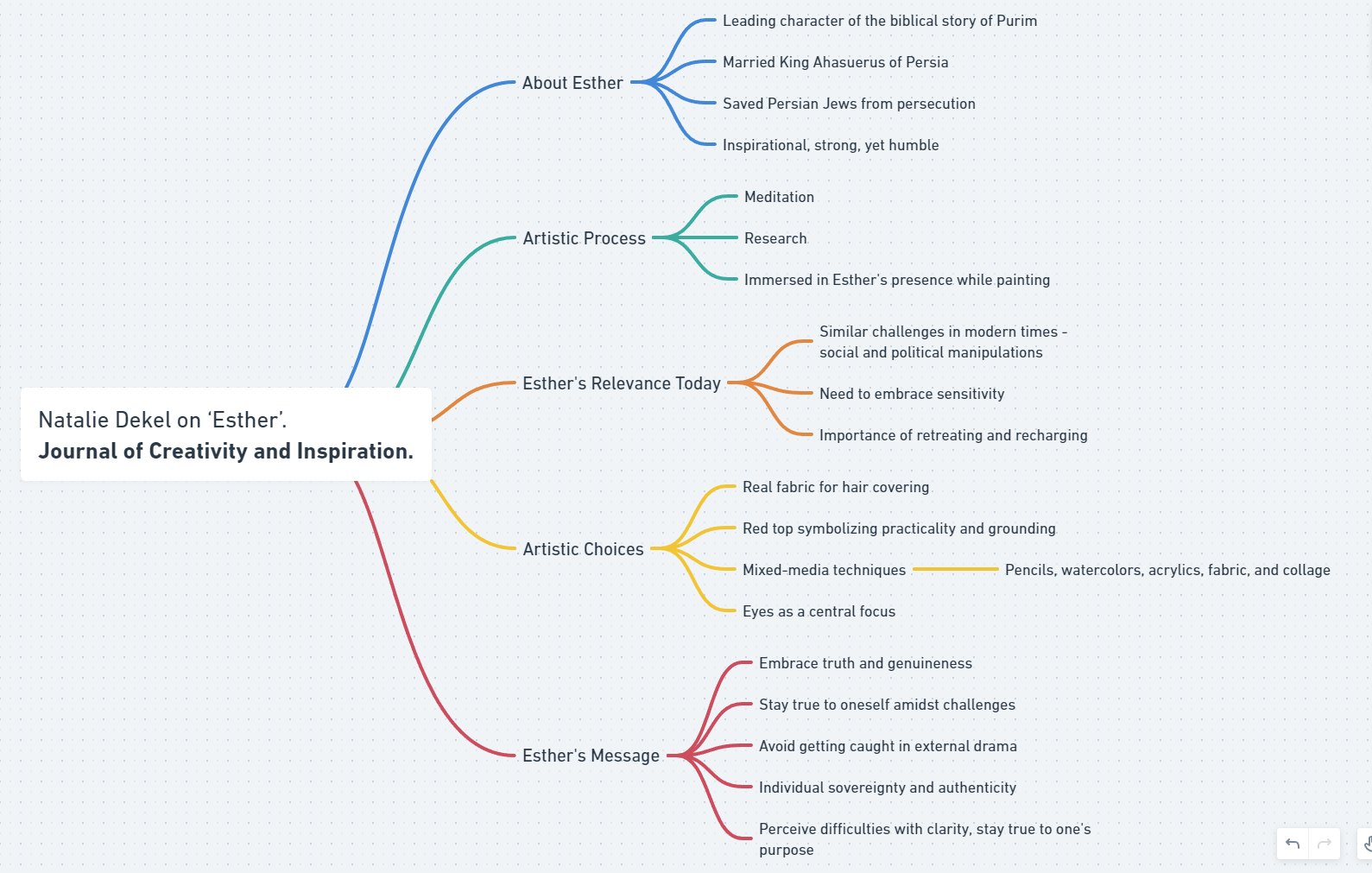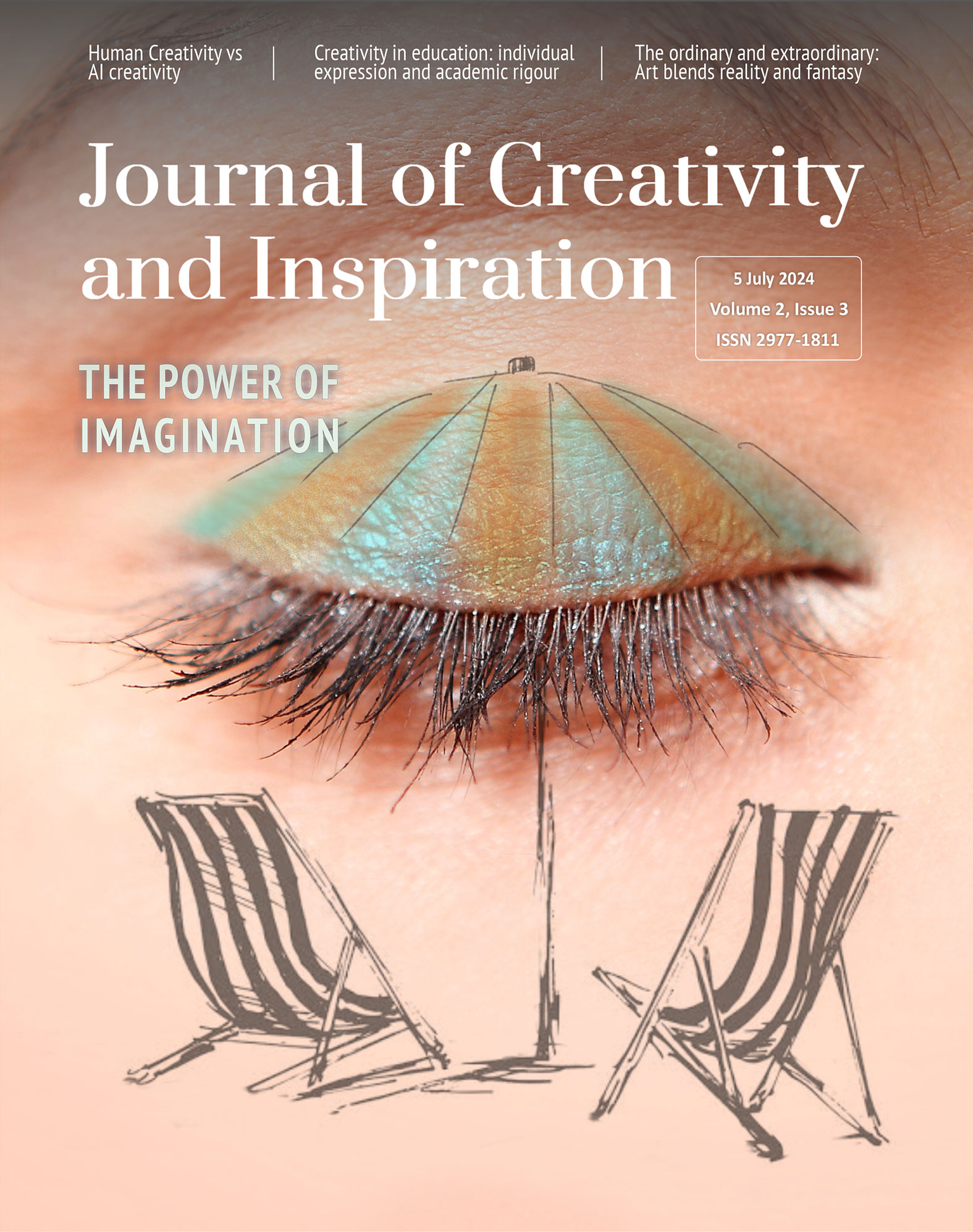Each ocean is made of drops of individuals: Natalie Dekel interviewed by Gil Dekel
5 July 2024 – Vol 2, Issue 3.
Gil Dekel: You’ve named this work ‘Esther’.
Natalie Dekel: Yes, because Esther is a woman I’ve connected to. She is the leading character of the biblical story of Purim (4th century BCE) and she brings a message relevant to our times. I wanted the image to speak for her, and also bring forth the healing to each individual who engages with this image. Esther was a Jewish woman who married King Ahasuerus (אחשוורוש) of ancient Persia. Through this marriage, she saved Persian Jews from persecution during her reign. She was truly a strong, inspirational woman, despite not saying many words. She didn’t want to be in the limelight; she just wanted to do the work to connect people and bring peace and abundance to those around her. She had no interest in power, fame, or money.

Natalie Dekel next to a canvas print of her painting ‘Esther’. (Photo by Gil Dekel, 2022).
Gil: How do you choose the subjects for your paintings?
Natalie: When creating art, I start with a meditation to connect to the personality I would paint. I speak to them; I do research. As I painted Esther’s essence, it felt as if her being was overshadowing mine for a moment. I became her while painting. I cease to be me, and become her.
Gil: Why did she choose to come now?
Natalie: She came now because the world is facing the same challenges today as in her times. Just like in her times, there is now a sense of uncertainty in our world. In her times there was a desire to persecute and blame a particular group of people for no other reason than political manoeuvres and powers.
When I connected to her, she wanted to say that we are not alone; we are strong together. It doesn’t matter what’s happening physically, mentally or emotionally… as long as you stay together, you stay true to yourself – a genuine, authentic being – without following the corruption, the power, the greed. You can stay genuine and therefore find your truth and your peace. Esther’s whole being is about authenticity and genuineness, and owning who you are and what you do.
Her message is that it is time to accept that what we thought was working for us, may not be working anymore. She is representing exactly that. She is representing that it is okay to accept our sensitivities, our emotions, our weaknesses because they can be the new leading power. She says it is okay to retreat, to go into yourself, to spend time by yourself. Once you discover your sensitivity and your light and power, you can support others.
Since we have been suppressing emotions for far too long, the energy is now splurging out and this can be overwhelming. It’s okay to go back to a safe place, to retreat, and recharge your energy. Don’t look back. Stay in the Now. Find who you are. Shed the cloak of the past and embrace your wisdom and power. Make that choice of following the inner truth.
Esther says that life may bring disappointments and you will have hard choices to make. At the same time, you will be tapping into an amazing inner power that will enable you to hold the truth and cut through illusions. It will help you follow what you need to achieve and see that things are more than just black and white.
Gil: You have added a real fabric to the painting, to cover her hair.
Natalie: Yes. Esther was a very private humble person. When she came to me, she initially didn’t want her portrait done at all. I’ve persuaded her because, in my experience, people connect strongly to faces, to visuals. The eyes are the mirrors of the soul. People want to see a face when they talk to you; people want to connect. I am partly deaf, so I personally need to see the lips to understand as someone is talking. I need the face to read the emotions, the thoughts, the feelings. The face is extremely important to me.
I said to her: ‘If you feel so embarrassed by being in the fame, in the limelight, we can add fabric so you can cover your face whenever you feel like.’ So, on the promise that I include fabric in this painting, she has agreed to be painted…
The fabric I used is translucent; it would be similar to the veils she had in her lifetime. They probably had silk material rather than what I used, but I used the fabric very femininely. And still, she is very strong even though she’s humble, and she wants to hide. Her name in Hebrew means hidden; even her original name remains a secret to most people around her. She didn’t want to be in any limelight; she just wanted to be honest and truthful, and this is her message.
This painting is part of a series of masters’ portraits, I am working on.
Gil: And the choice of colours? Why is she wearing a red top?
Natalie: I felt that she was a very practical person, very grounded, even though she’s quite spiritual. All of her actions, all of her thoughts were practical, functional. There was nothing fluffy or woolly about her message. Red is the colour of the root chakra, the foundations, the physical needs, the safety. I used it to show that she’s like a mother figure. She’s a grounded, person rooted in reality and practicality.
Red and blue in art represent heaven and earth. I wanted to create a person who is bridging the two worlds, who walks between worlds.
Gil: What materials did you use for this piece?
Natalie: The face is drawn with pencils, watercolour pencils, and some acrylics. The rest is fabrics and a collage. It’s a mixed-media work. The background is a collage, using papers that are usually used for decoupage or scrapbooking.
Gil: How was it working with collage along with acrylics and pencils?
Natalie: I find that reality is never one aspect; it is not singular. To understand reality means to have mixed complex aspects. By mixing materials, I allow different aspects of reality to interweave into something new.
Paper is rather solid; it has originated from trees, wood; it has a different feel to it than pen or acrylics. Pen starts something from a single point of existence and then it unfolds. And acrylics create something emotional and material from nothing just with a stroke of a brush. With readymade papers, you create something from something, since the paper already exists with the pattern already printed, so in that respect you combine worlds within worlds, adding layers of existence and awareness.
Gil: She has a strong gaze, looking directly at us. It does not seem shy at all.
Natalie: It is honesty and truth. Her message is through her eyes. I use the eyes as a message material. She doesn’t want to be seen, but when she speaks, you will hear her. It’s not about shyness like in our society; she was not shy when she had to speak. She just didn’t want to be in the public eye. This has nothing to do with shyness. People think that being shy is an affectation; it’s a behaviour of inverting yourself, going inwardly, and being embarrassed. But no, it is not about embarrassment with Esther. She’s an extremely private person, but for the message, she was able to come through and deliver the message. It’s honesty and authenticity without ego being present.
When you connect to the painting, you will hear the message you need to hear. She will deliver the message to anyone who truly looks into her eyes.
Gil: She appears a bit pale.
Natalie: Yes, I believe she was slightly anaemic. She was married to a king, so obviously the clothing was of top quality. Her appearance was important because she represented something of beauty and wisdom to the king. She was preparing every time she appeared in public; she would prepare for weeks ahead. Her body, her face, her appearance was a work of art. But in reality, she was a simple, plain orphan girl, raised by her uncle in ancient Persia. In any other circumstances, she would be considered nobody. It is simply the chance and the circumstances that brought her to participate in a lottery that the king ordered, in which she won the competition, the pageant, to become the wife of the king. So, her true nature is honest, simple, and genuine.
Gil: What did she do after this marriage?
Natalie: In terms of the Jewish culture, she managed to rescue her people from persecution and avoid numerous political killings. Secondly, I believe she was extremely intelligent, and she managed to make her kingdom quite wealthy, although she was never in the public eye. All the assets, money, and success went under her husband’s name.
Gil: So, her skills and wisdom are needed now.
Natalie: There are repeating circumstances where political agendas throw certain types of people under the bus for whatever reason. There is growing hate crime, victimization, and harassment. The crowds seem bloodthirsty; they don’t particularly mind who’s to be thrown under the bus. Just like in the times of the gladiators, people would come to watch and demand blood. People tend to look for drama. Esther came to remind us that this is not who we are. We are never victims of circumstances. We should not become so embroiled in the stories that others create. We should not forget who we are and our genuine purpose here.
Esther is delivering a message of how we should perceive difficulties and stay true. It’s very easy to slip down the hill of reaction. Reaction to hot speeches and high emotions. The media sells stories for money, greed, and power. Whoever is running the show has an agenda. There is always a global story and a global agenda that everybody runs after and repeats blindly. She simply asks people to wake up to reality, and make their own minds; make their own decisions.
Esther reminds people who they are. If we stay in our sovereignty, our authenticity, our genuine being, we will not get caught in another people’s drama. You cannot change the world as a whole, but if you change who you are, you will affect hundreds around you. This is her message. Each ocean is made of drops of individuals. Although it may look like we are currently in a tsunami of anger and hate, remember that it is made of individual drops. It starts with you.
At a glance:

© Journal of Creativity and Inspiration.
Images/art © the artists.
Natalie Dekel, MPhil, B.Ed, BA, is a fully certified hypnotherapist (dip HSOH), Reiki Master/Teacher, Yoga Teacher and visionary artist. She has been offering healing and guidance since 2007. Natalie is the co-author of the ‘Energy Book’.
Gil Dekel is a doctor in Art, Design and Media, specializing in processes of creativity and inspiration. He is a lecturer, visionary artist, Reiki Master/Teacher, and co-author of the ‘Energy Book’. He was awarded the Queen Elizabeth II Platinum Jubilee Coin, in recognition of his dedication and commitment to pastoral work at Hampshire Constabulary.
